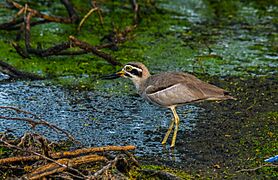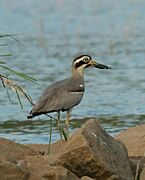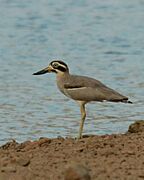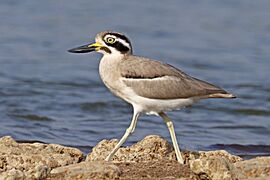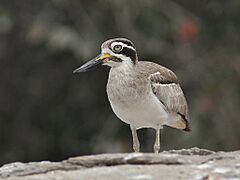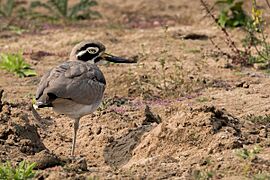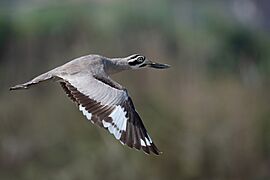Great stone-curlew facts for kids
Quick facts for kids Great stone-curlew |
|
|---|---|
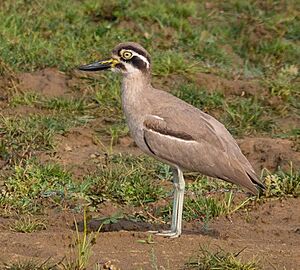 |
|
| At Chambal River, Uttar Pradesh, India | |
| Conservation status | |
| Scientific classification | |
| Genus: |
Esacus
|
| Species: |
recurvirostris
|
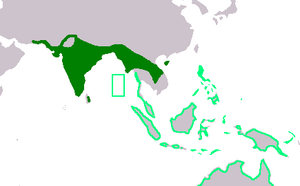 |
|
| E. recurvirostris range E. magnirostris range | |
The great stone-curlew or great thick-knee (Esacus recurvirostris) is a large bird that lives near water. It's a type of wader, which means it's a bird that often walks in shallow water or on wet ground. These birds live all year round in warm parts of southern Asia, including countries like India, Pakistan, Sri Lanka, and Bangladesh, stretching into South-east Asia.
Contents
How Scientists Named This Bird
Scientists give every living thing a special two-part name, like a first and last name. This helps everyone around the world know exactly which animal they are talking about.
The First Name: Oedicnemus recurvirostris
The great stone-curlew was first officially described in 1829. A French scientist named Georges Cuvier gave it the scientific name Oedicnemus recurvirostris.
The second part of its name, recurvirostris, describes its unique bill. It comes from two Latin words: recurvis, meaning "bent backwards," and -rostris, meaning "-billed."
Its Current Name: Esacus recurvirostris
Later, in 1831, another French scientist named René Lesson decided this bird needed its own special group, or genus. He created the genus Esacus just for the great stone-curlew. So, its full scientific name today is Esacus recurvirostris.
What Does the Great Thick-knee Look Like?
The great thick-knee is a fairly large bird, growing to about 49 to 55 centimeters (about 19 to 22 inches) tall. It has some very noticeable features.
Its Unique Bill
One of the most striking things about this bird is its huge bill, which can be about 7 centimeters (almost 3 inches) long. The lower part of its bill has a sharp bend, making it look like it's pointing slightly upwards. The bill is black with a bright yellow base.
Feathers and Eyes
Its upper body and chest are a plain grey-brown color, without any stripes. The rest of its underside is whitish. Its face has a cool pattern of black and white markings. The bird's eyes are a bright yellow, and its legs are a duller greenish-yellow.
In Flight
When the great thick-knee flies, you can see black and white feathers on the top side of its wings. The underside of its wings is mostly white. Male and female birds look very similar. Young birds are just a bit lighter in color than the adults.
How the Great Thick-knee Lives
These birds prefer to live near water. You can often find them on gravel banks along rivers or large lakes. They also like sandy beaches.
Daily Habits
Like other stone-curlews, the great thick-knee is mostly active at night or during twilight hours (dawn and dusk). However, you can often spot them looking for food during the day. They move slowly and carefully, sometimes making short, quick runs.
Being Wary
These birds are quite shy. If they see someone approaching, they will usually fly away into the distance. They fly with strong, somewhat stiff wingbeats.
Sounds and Food
The great thick-knee makes a wailing whistle sound, mostly at night. This is similar to the calls of other birds in its family. They eat crabs, large insects, and other small animals they can catch.
Reproduction and Life Cycle
When it's time to lay an egg, the female bird simply lays a single egg in a shallow dip on the open gravel or shingle. There isn't much of a nest built.
Image gallery



